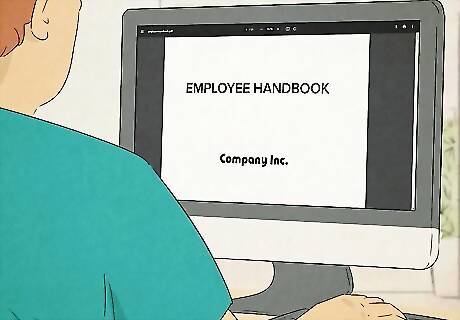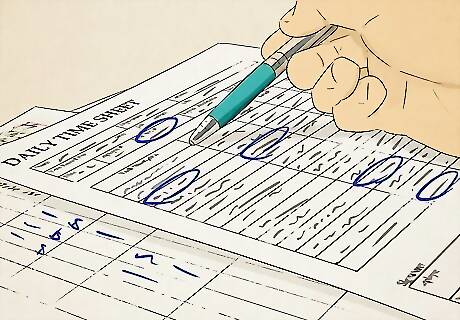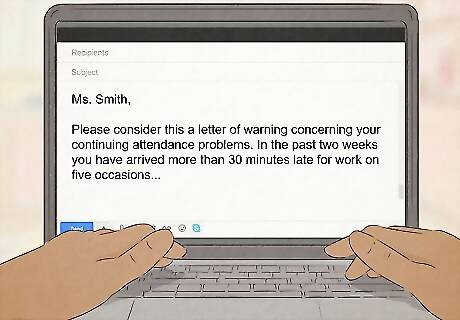
views
Addressing the Problem

Identify the problem behaviors. Closely watch the employee to see if tardiness is the only issue of concern with their job performance. If they are also sloppy in their work or disagreeable to their coworkers, then you may need to address these problems as well in your meeting. Pay attention to see if their productivity has clearly suffered as a result of their lateness. Make a quick note in your phone or jot down your observations in a small notepad that you keep on you. This will allow you to recall everything clearly later on.

Intervene quickly. It is key that you not allow this issue to go on too long. Begin planning a meeting as soon as you see your employee behaving in problematic way. If you wait, there is a possibility that it will only get worse. You also run the risk of alienating other employees who have to pick up the slack from the slacker. As you plan for the meeting, think about the level of trust and rapport you have with the employee.

Review the company’s Employee Handbook. If you work at a larger business, there is likely a detailed manual to guide your actions in situations of employee discipline. Skim through the book to see if there is a section that pertains to tardiness. Ideally, you will find a statement outlining a clear, coherent attendance policy. If your place of work does not have an employee manual, then you will need to rely on your personal observations and past practices to guide your actions. For example, if the employee consistently comes in 15 minutes late, then this is an obvious violation of the schedule.

Speak with the Human Resources Department. Send a quick email, make a phone call, or drop by in person at your company’s HR Department. Tell them about the situation, ask for their advice, and ask them what they need from you in terms of paperwork. It is possible that they will need an acknowledgement signed by the employee or a summary of the conversation from you for the employee’s record. It is also possible that the HR people know something regarding the employee’s personal or medical life that you do not. For example, the employee may have approached them regarding using part of a medical leave. Ask HR to educate you regarding any company leave policies that could pertain to this employee.

Gather all necessary documents and facts. You’ll want to get your hands on any payroll records or timesheets showing additional absences or attendance overall. You may want documentation showing prior incidents of lateness, their impact, and the reasons provided by the employee. Having employee performance evaluations in-hand is also a good idea.
Conducting the Meeting

Meet with the employee in private. It is best if your first conversation is one-on-one. You definitely want to meet somewhere where other employees will not be privy to your conversation. You can ask the employee to meet you in your office at a certain time. Some supervisors prefer to casually ask the employee, “How are you?,” a few times before setting up anything formal. If you know the employee quite well and think a casual approach may be best, you could leave the office together to go grab some coffee and discuss everything. To set up a meeting, you might say, “Hi, Tom. Good morning, would you mind stopping by my office after lunch?”

Explain the reason for your meeting. You can open the meeting with some general niceties, but it is a good idea to explain why you asked them in early on in the conversation. You might explain that you’ve noticed a change in their work patterns and wanted to get their take on everything. You could also describe how productivity had dropped and you noticed their tardiness might be a contributing cause. Be tactful here as you want to leave plenty of room for them to explain, especially if they are an otherwise good employee. You might say, “Tom, I’ve noticed that you’ve been late quite a bit lately. Can you tell me what’s been going on?” Then, “Tom, your coworkers very much rely on your good work and I’ve noticed a slowdown in productivity lately.” You could also say, "Hey Susan, is everything okay? I noticed that you've been kind of late. Is there something we need to talk about?" You might also ask, "Are you feeling stressed out?" or "Is there something that's hindering your performance?"

Lay out the details of the attendance policy. This is where you explain what you found in the employee handbook. Or, you can tell them what is acceptable in terms of lateness and absences and where the line is drawn. This is also important to do quite early on in the conversation, as it is possible that the employee didn’t understand the policy fully or misinterpreted something from HR. You might say, “Tom, we do need at least 24-hours’ notice if you are going to be late for a work day.”

Explain the ramifications for future tardiness. This is where you will need to lay down clear rules and consequences while also being as flexible as you can. You might ask them to make up the time each week. Or, you might issue a written warning leading eventually to termination. You could just ask them to leave immediately if they arrive late and dock their pay. Make sure to match your response to the issue. It also helps to know your employee. Some people respond best to very clearly established consequences while others do better if you just ask for their assistance in complying.

Tell them what you expect from their future performance. This is where you both can work on a positive and proactive solution. Discuss flex time as an option. Or, maybe see if they can carpool with others for accountability. Talk about working from home, if needed, or perhaps even taking a leave of absence. If the lack of notice is your real concern, perhaps set up a system where they can text or email if they’ll be running late in the future. This is also where you’ll want to talk about any other behavioral issues, such as poor attitude. However, be careful not to overwhelm your employee or you could get a negative, defensive reaction.

Answer their questions. Before you conclude the conversation, make sure to ask them if they have any questions or concerns that they would like you to address. And, whatever they ask, do your best to give them as much information and guidance as you can without appearing condescending. If you don’t know the answer, refer them to HR or someone who can help. You might say, “Before we wrap everything up, do you have any questions for me? I want to make sure that you are clear on everything we’ve gone over.” You could also help walk your employee through possible solutions, like ways to leave their home earlier or tips on beating traffic.

Send a copy of all documentation to Human Resources. Get any documents signatures that you need. And, make additional copies for your own records and those of HR. It is a good idea to keep general summaries of disciplinary conversations within an employee’s work file. These documents will serve as a record in case you need to have another conversation or pursue termination of employment.

Pay attention and reward any improvements. It is highly likely that your employee will begin to improve their performance following your conversation. As you watch to see how they are doing, make sure to note any progress and encourage it, no matter how small.
Maintaining Professionalism

Stay calm. Remember that you are the person setting the professional tone for your conversation. Take a deep breath or count to ten in your head if you need to calm down. Stick to the issues at hand and try not to veer off subject. Remind yourself that you are trying to help them, but you also need to do your job.

Do not tolerate personal insults or abuse. The employee may respond negatively to your comments and may react by lashing out. If this happens, it is best if you both step back for a bit. Ask the employee to leave for the day and state that you will resume the conversation tomorrow with HR present as well. You must maintain a degree of authority here or you will lose the ability to guide this employee’s behavior and ensure the company’s productivity. This is another reason why you want to have this conversation sooner rather than later. If you wait too long before talking with them, they may feel as if you should’ve warned them earlier.

Bring in a witness, if needed. If you feel that the conversation may go badly, it is probably a smart idea to invite a member of HR or another supervisor to sit in on the talk. They can help to reinforce what you say about the rules. An employee will also be less likely to get agitated when faced with two calm people.

Give them a written explanation option. If the employee is uncomfortable talking with you about their situation, you might want to allow them to write an official letter stating the reasons for their actions and their desire to improve in the future. Request that they explicitly agree to specific measures of improvement in the future. This letter should also be placed with an employee’s official file with HR.

Direct them further up the chain of command. If the employee seems unwilling to change or refuses to talk civilly with you, it may be necessary to put them into contact with your supervisor or HR directly. Give the other party a heads up if you do this, so that they’ll know what to expect.


















Comments
0 comment